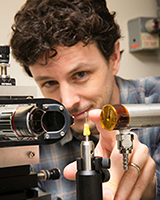NASA Early Career Faculty Award for CHESS user Joshua Choi
Josh and his students have already performed first x-ray scattering experiments related to this project at D1 station in the summer run 2015.
The NASA Program aims to support “early stage technologies that will address high-priority needs of America's space program” (see NASA Press Release). Eight projects were selected out of a national competition which will be funded for $200K per year up to three years.
We congratulate Josh and are looking forward to more exciting experiments of his group at CHESS!
